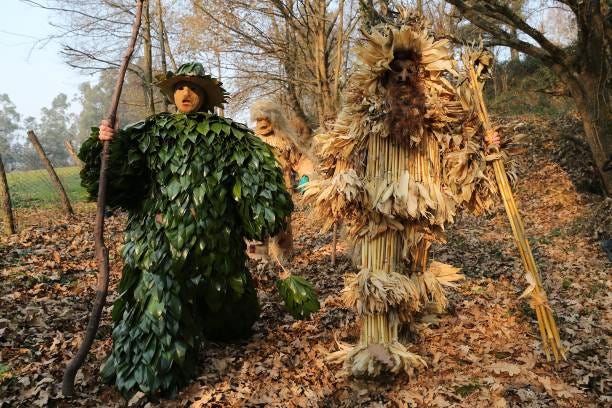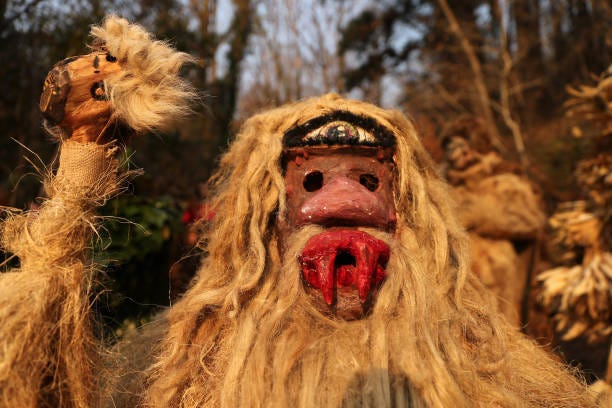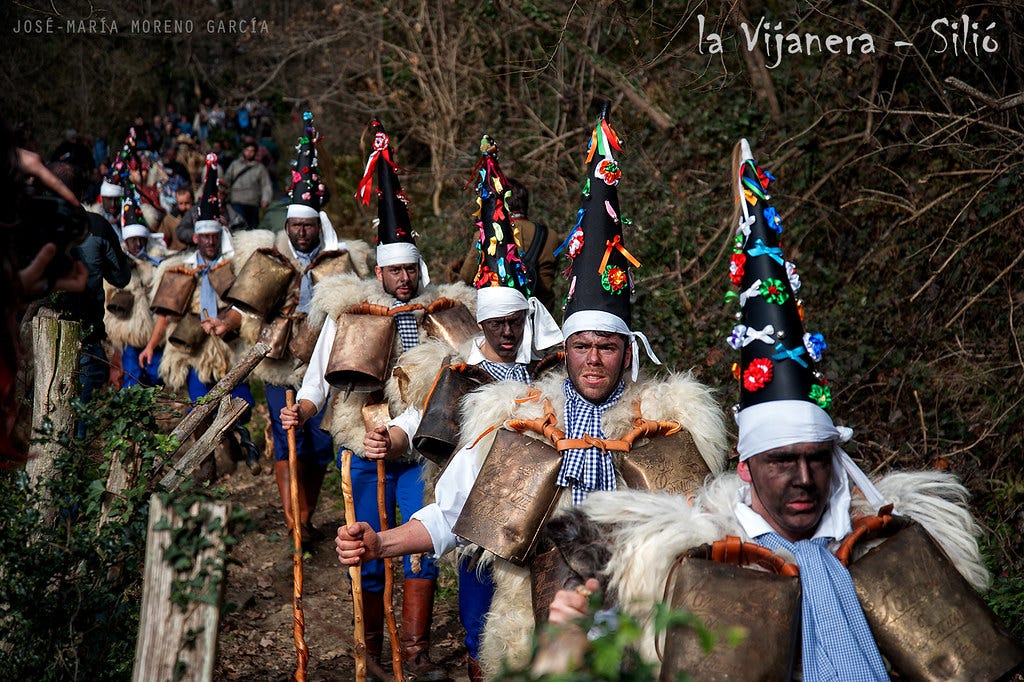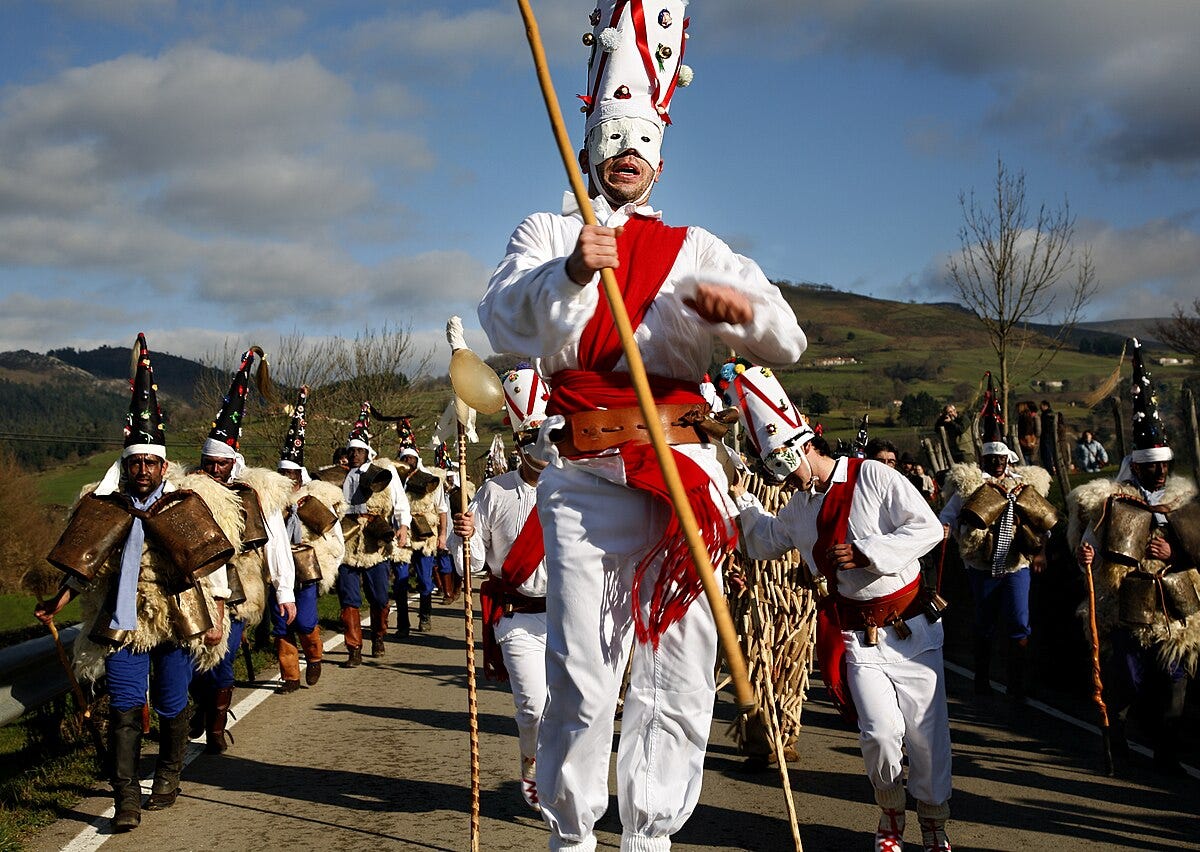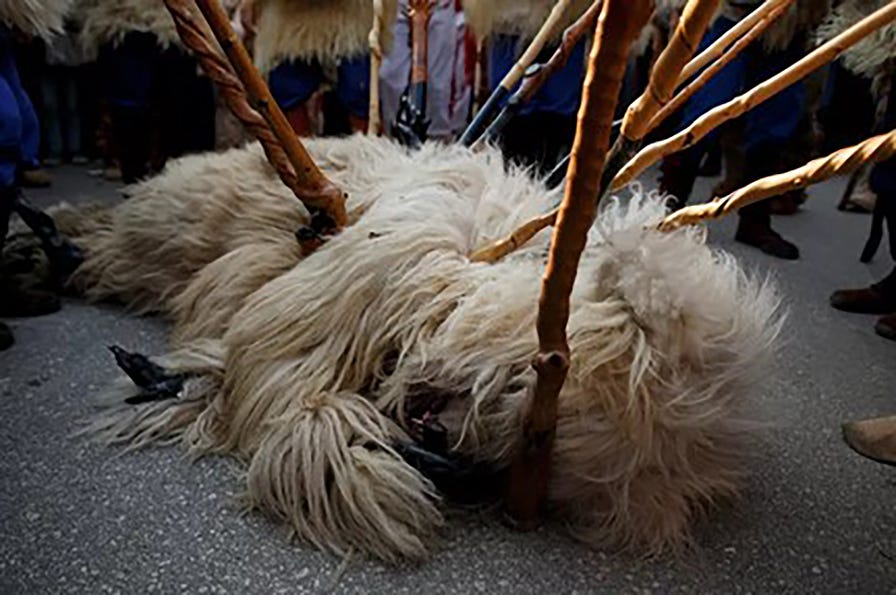

Discover more from Food and Fiesta
The Ancient Pagan Festival of La Vijanera
This small Cantabrian village welcomes in the New Year by banishing beasts, devils, and evil spirits from the Old Year with a unique and colourful carnivalesque fiesta.
Every year on the frigid first Sunday of January, the village of Silió is awoken before dawn to the sound of an exploding rocket followed by the clanking of bronze cowbells through the streets. Nestled among the green hills of the Cantabrian Mountains in the north of Spain, this village is about to re-enact one of the oldest and most unusual pagan festivals in Europe.
Around 170 men from Silió and the surrounding villages dress in hefty suits of moss, leaves, bark, sticks, straw, husks, bamboo, and sheepskin. But this is ‘forest meets carnival’ with many others wearing suits of coloured rag, masks, uniforms, and a plethora of other costumes representing dozens of characters in the ancient festival.
The Vijanera Festival has been declared of National Tourist Interest and an asset of intangible ethnographic cultural interest, attracting increasingly more visitors each year, despite the nippy sierra temperatures. It dates back to the Celtic rites of the winter solstice that celebrated the reawakening of nature from its long winter lethargy. The rites were a way to close the past year and prepare the next by banishing evil spirits and welcoming in the good ones, ensuring the continued fertility of the earth.
The name of the festival traces its roots to the Roman god Janus – god of duality, new beginnings, transitions, doors, and passages. He is represented with two faces – one looking forward and the other backward – and was venerated during the Kalendas of Janus at the start of the new year. (It’s where we get the month January.) The Romans were known to adopt the local customs and traditions of their conquered subjects, who in these northern parts, often dressed up as various animals and other nature-inspired beings.
With a population that keeps getting older or migrating to cities, Silió is suffering the fate of many other mountain villages. From 3,115 inhabitants in 1960 to 1,495 in 2022, the municipality of Molledo originally celebrated La Vijanera in several of the valley’s neighbouring villages, but now only Silió, with its diminutive population of 620 (the largest village in the municipality), ensures the tradition is continued and passed down from generation to generation. But how do you keep a tradition alive when there are so few people to pass it down to? Tourism, especially regional and national tourism, but also the growing international interest in these fiestas, helps maintain the ethnographical value emblematic of its culture and people.
Many of these ancient festivals have been in danger of extinction a few times over the centuries due to their pagan nature, with the Inquisition banning such practices in 1786 and the church again in 1937 under fascism. The fiesta was revived in 1981 when a few young people from the valley learned about it from grandparents and black and white photos.
Today, the winter solstice festival brings together the numerous distinct traditional characters including various animals, a knight, a pregnant woman, doctor, dancers, guards, a Hungarian, a bear and its master, an elderly couple, a fortune teller, witch, devil, and many more. Each character has its own symbolism and role within the story, all played by men, including the women characters, for reasons that I’ve been unable to find.
The most important characters in the story are the Bear and the Zarramacos, dressed in sheepskins vests and pointed hats. The Zarramocos paint their faces black to represent the darkness that lures the Bear from its lair. If the Bear, which symbolises evil, believes there is a full moon, it will return to its den, prolonging the winter as a result. However, if there is a new moon, it will leave and the Zarramacos will have the opportunity to kill it, thereby expelling the evil spirits from the village. Several large bronze cowbells hang from their sheepskins which clang loudly and ceaselessly as they dance and pursue the Bear.
Brown bears used to be a common feature in these mountains but as they were often responsible for killing off the livestock, they were hunted to near extinction by the 20th century. However, the Fundación Oso Pardo has been working on conservation projects to reintroduce them to the Cantabrian Sierra, and in 2020, there were estimated to be 370 bears in the mountains, and this number seems to be growing.
The Fiesta
To make sure the village is well and truly awake by dawn, the youngest villagers ring cowbells through the streets, thus setting the tone (literally) for the rest of the day. The constant rhythm of the bells accompanies the participants as they begin to prepare for the festival, with friends and family helping them step and squeeze into their heavy, lush and leafy costumes, some weighing up to 40kg – excellent insulators against the frosty mountain air.
The White Dancers with their red sashes and tiny bells around the waist lead the energetic retinue through the forest in search of the Bear which is usually found hiding out in a cave (resembling more a polar bear than a brown bear with its long shaggy sheepskins). They chase the Bear through forestal paths to a hill overlooking the village where they torment it, hitting it with sticks all while the Zarramacos continue to clang their bells in an effort to drive out the evil spirits.
The entourage makes its way back down to the village square for the coplas – a series of satirical songs, ballads, and speeches performed on a makeshift stage, that touch on local politics and other events that have occurred around the municipality during the past year.
The final act takes place in the Plaza de la Iglesia beside the small Romanesque church. The ill-fated Bear is escorted into the square by the Zarramacos who crowd around the beast in a rhythmic dance, cowbells beating in unison. They hit the Bear with their sticks until it lies unmoving in the centre of the circle – its demise is the symbolic death of the old year and the beginning of the new.
There are a few other acts that take place during the course of the festival, such as a confrontation with a neighbouring group at the limits of the village with whom they settle outstanding quarrels. As there are no longer any neighbouring groups participating in the fiesta, the act consists of the Black Dancer blowing his horn and shouting “War or Peace?” The group shouts “Peace” and they move on.
Then there are the Pregnant Woman and her Husband. Each year in an open-air theatrical performance, she gives birth to a different animal, representing a new beginning. Every character has its role in the story though its purpose is not always clear to the spectators. The Rag People, (Trapajeros), carry a stick with pieces of cloth attached to the ends which they dip into puddles and flick at anyone standing close enough.
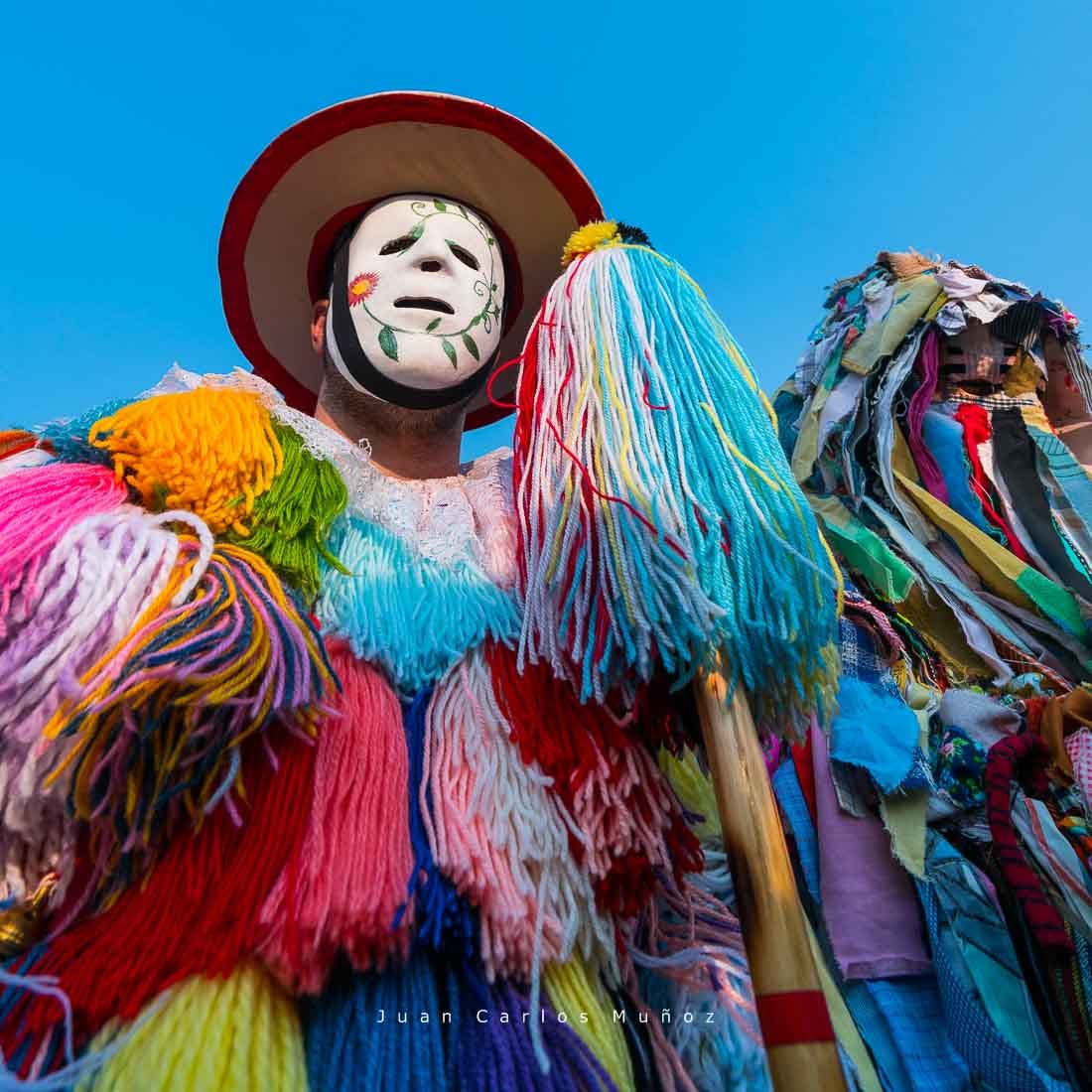
The Devil with his impressive beast’s head has the job of scaring people as do the Witch and Zingara who also wear threatening masks and represent evil. The Giralda is a 4-metre giant, and the Ojáncanu is a character from Cantabrian mythology documented in ancient vijaneras. Then there’s the Bride decked out in flowers and bows, the Groom in a black suit and top hat; Los Guapos (the Handsome Ones) beautifully clad in white lace, and the Gilonas dressed in old clothes and scary masks. There are various professions represented such as a Doctor, Nurses, Civil Guards, Photographer, Beekeeper, and other characters who parody contemporary events.
Once the Bear has been defeated and evil has been expelled from the village, the characters, exhausted from their hours of jumping, jogging and dancing in heavy suits and thick grotesque masks, go off to the bars and taverns with friends and family to drink, eat, and be merry till late.

La Vijanera is an ancient tradition that has survived the dilution of time and continues to be passed down from generation to generation. Everyone in the family, male and female, learn the story and meaning of the festival and its unique characters from the time they are very young. In the last few years, the village has organised the Vijanera Infantil the day before the festival in which the smallest of the community participate, including girls. While the characters may be male, the women play an important role in the fiesta’s organisation and fabrication of the costumes and masks. With their participation throughout childhood, it becomes a part of their identity, connecting them to their land, village, and cultural history.
UNESCO’s initiative to help protect and preserve these customs as “Intangible Cultural Heritage” ensures they continue to be practiced in communities around the world. Spain’s regional diversity and rich cultural traditions are unique and it’s gratifying to know so many still thrive and continue to grow in popularity.
The below video is a well-made and haunting depiction of the fiesta.






